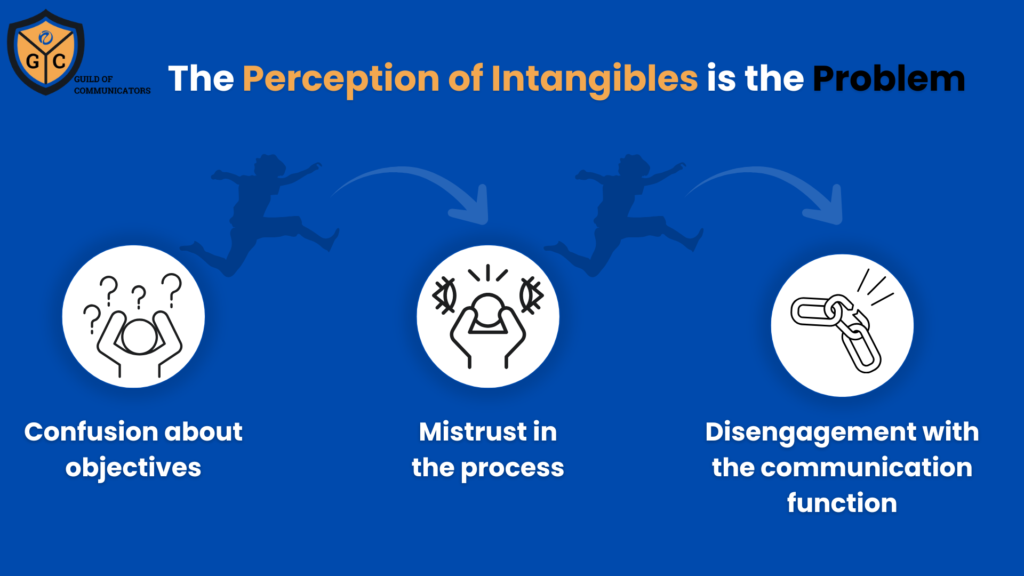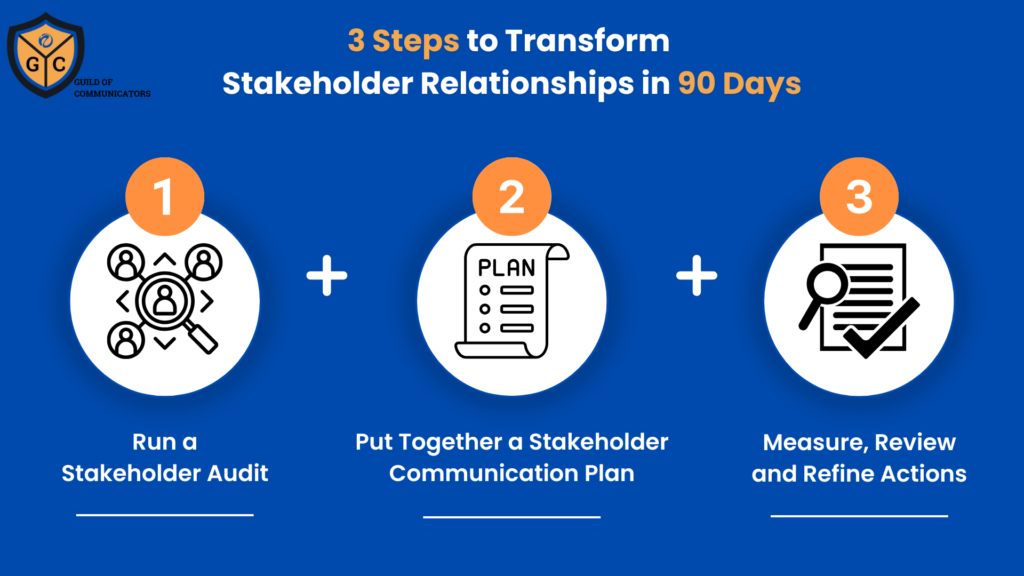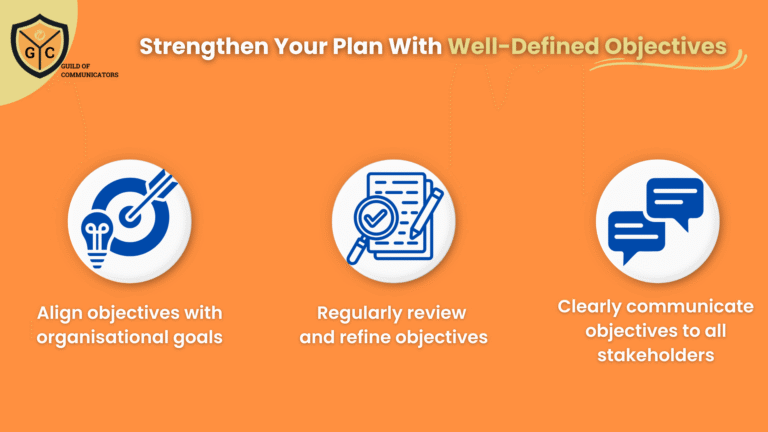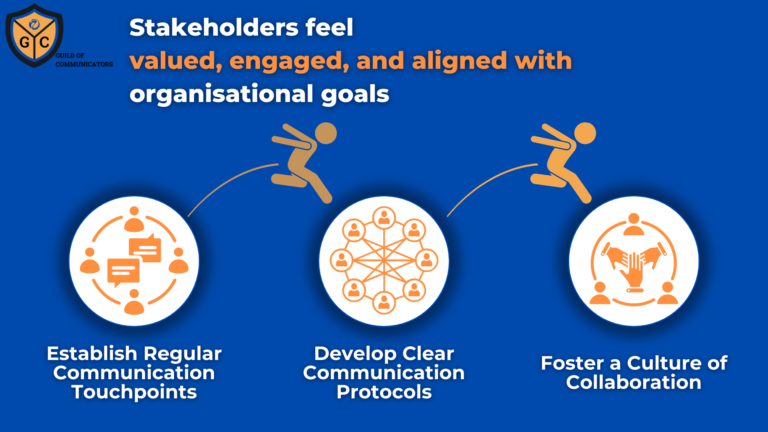Effective communication with stakeholders is a cornerstone of a successful communication function.
While external communication often garners the most attention, (internal) stakeholder communication is equally critical to organisational success. Without clarity and alignment internally, even the most polished campaigns can falter.
Stakeholders are often the decision-makers or key influencers in your organisation. Their buy-in, support, and understanding of communication strategies can make or break a project. Yet, ensuring effective communication with stakeholders remains a persistent challenge.
Why? Because stakeholders are not just an audience; they are active participants in shaping strategies. As communicators, we need to prioritise structured and effective stakeholder communication to foster collaboration, achieve alignment, and drive outcomes.
How Gaps in Communication Impact Stakeholder Relationships
When communication with stakeholders is inconsistent or unclear, the consequences ripple throughout the organisation. Misaligned priorities, duplicated efforts, and delays are just some of the outcomes of poor communication.
For stakeholders, a lack of proper communication can lead to confusion about objectives, mistrust in the process, and disengagement from the communication function. These gaps weaken relationships and diminish the credibility of the communicator.
Without strong communication, stakeholder relationships often become transactional rather than collaborative. This limits the potential for meaningful engagement and stifles the ability to achieve strategic goals.

The Realities of Stakeholder Dynamics: Time-Poor and Distracted
Stakeholders are frequently time-poor, balancing competing priorities and dealing with constant demands on their attention. As a result, they may lack the capacity to engage deeply with communication strategies or to fully understand their nuances.
Another challenge lies in stakeholders’ varying levels of familiarity with the communication function. Many may view it as a support role rather than a strategic driver, which can lead to misunderstandings about its importance.
These realities make it essential for communicators to adopt a proactive and empathetic approach.
Recognising these challenges and tailoring your communication methods accordingly can help bridge the gap and foster stronger relationships.
How to Simplify Stakeholder Interactions with Systems
The key to overcoming these challenges lies in building systems and structures that streamline stakeholder communication.
Systems provide consistency, clarity, and efficiency, making it easier to engage even the busiest (or most distracted) stakeholders.
One effective approach is to implement regular communication touchpoints, such as monthly updates or quarterly review meetings. These ensure stakeholders remain informed and aligned without needing constant ad hoc interactions.
Additionally, creating clear documentation—such as stakeholder engagement plans, decision-making matrices, and communication protocols—provides a framework for collaboration. These tools help set expectations, minimise misunderstandings, and establish a shared understanding of goals.
Making Communication Effortless with the Right Structure
Structure simplifies complexity. When systems are in place, communication becomes a seamless process rather than a reactive effort. Stakeholders know what to expect, when to engage, and how their input will be used.
With structure, communicators can focus on delivering value rather than firefighting miscommunication. It creates a foundation for trust, as stakeholders see a consistent, organised approach to engagement.
Moreover, structured communication allows for better use of time and resources. It eliminates inefficiencies and ensures that efforts are aligned with organisational priorities, driving better outcomes.

Three Steps to Transform Stakeholder Relationships in 90 Days
The aim of effective stakeholder communication is to build strong, collaborative relationships that support organisational success. When communication is clear, structured, and consistent, stakeholders are more likely to engage proactively, contribute meaningfully, and align their priorities with broader goals.
A well-communicated relationship fosters trust, accountability, and mutual respect. It ensures that stakeholders feel heard, valued, and empowered to participate in decision-making processes. The result is a more cohesive and effective organisation, where communicators are seen as indispensable partners in achieving strategic outcomes.
Achieving this vision requires deliberate effort and a clear roadmap.
The following three steps provide a practical guide to making significant progress in stakeholder communication over the next 90 days.
Conduct a Stakeholder Audit:
Start by identifying who your key stakeholders are and understanding their needs, expectations, and communication preferences. This step is critical to ensure that your communication efforts are targeted and relevant.
- Map Stakeholder Roles: Create a stakeholder map that categorises individuals by their influence, interest, and involvement in your projects.
- Assess Current Communication: Review the existing channels, frequency, and content of your communication with stakeholders. Identify gaps or areas for improvement.
- Understand Stakeholder Priorities: Engage directly with stakeholders to understand their concerns, objectives, and preferred methods of interaction.
This audit will provide a foundation for tailoring your communication strategy to meet stakeholder needs effectively.
Develop a Stakeholder Communication Plan
Once you have a clear understanding of your stakeholders, it’s time to create a structured communication plan. This plan will serve as your roadmap for consistent and impactful engagement.
- Set Clear Objectives: Define what you want to achieve through your communication efforts, such as improved alignment, increased buy-in, or enhanced collaboration.
- Outline Communication Channels: Choose the most effective channels for reaching your stakeholders, whether it’s email updates, one-on-one meetings, or team briefings.
- Establish Regular Touchpoints: Schedule regular check-ins, such as monthly status updates or quarterly strategy reviews, to maintain ongoing engagement.
A well-crafted communication plan ensures that your efforts are intentional, aligned with stakeholder needs, and focused on achieving specific outcomes.
Measure and Refine
The final step is to evaluate the effectiveness of your communication efforts and adjust as needed.
- Collect Feedback: Use surveys, informal conversations, or feedback sessions to gather insights from stakeholders about what’s working and what’s not.
- Track Key Metrics: Monitor indicators such as response rates, engagement levels, and alignment with organisational goals to assess the impact of your communication.
- Adjust Your Approach: Use the feedback and data collected to refine your communication strategies, addressing any identified gaps or challenges.
This iterative process ensures that your stakeholder communication remains relevant, effective, and aligned with evolving needs and priorities.
Over time, this approach will help position the communication function as a strategic enabler, build trust and collaboration, and drive meaningful organisational outcomes.
*****
Join the Guild of Communicators at www.gocommunicators.com.
The Guild of Communicators (Go Communicators) stands as the preferred community for communicators seeking to elevate their craft. Through our Academy of Excellence, we provide best-in-class frameworks, fit-for-purpose resources, and opportunities that support members in achieving professional excellence.
We provide the following resources, tools and opportunities to members:
- Best-in-Class Resources: We provide our members with access to frameworks, playbooks and tools that empower them to achieve and maintain professional excellence.
- Continuous Learning and Growth: Through our comprehensive training programmes, workshops, delivered digitally, 24/7 and in-person, we support the ongoing professional development of communicators.
- A Supportive Network: GOC fosters a vibrant community where communicators can connect, collaborate, and support each other, creating a network that champions mutual growth and success.
- Shared Knowledge and Expertise: Our members benefit from the collective wisdom and experience of a diverse group of communication professionals, enhancing their skills and perspectives.
Go Communicators is dedicated to amplifying the impact and value that communicators bring to their organisations, highlighting their crucial role in driving success and growth.
We equip our members with the strategies and tools needed to become influential leaders and business partners within their organisations, enhancing their ability to drive positive change and outcomes.
Through our support and resources, communicators can demonstrate clear, measurable outcomes that showcase their value and impact, reinforcing their importance to their organisations.
Join the Guild of Communicators at www.gocommunicators.com
Subscribe to join over 1500+ communicators and brands getting value every Tuesday while reading A Communicator’s Perspective, our weekly newsletter.




